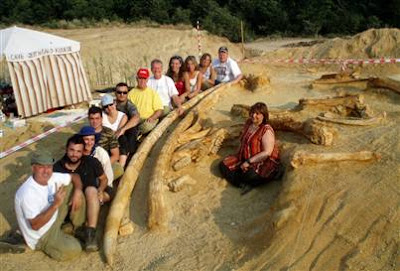 The two well-preserved tusks seen above are among the recently unearthed parts of a mastodon—a prehistoric elephant-like mammal related to the mammoth—found in northern Greece.
The two well-preserved tusks seen above are among the recently unearthed parts of a mastodon—a prehistoric elephant-like mammal related to the mammoth—found in northern Greece.Measuring 16.4 feet (5 meters) and 15 feet (4.6 meters), the toothy remains "are the longest tusks ever to be discovered in the world," team leader Evangelia Tsoukala of Aristotle University in Thessaloniki said in an email. The team, seen inset surrounding the tusks, also uncovered some of the animal's leg bones and parts of a jaw with molars.
The mastodon was probably between 25 and 30 years old when it died, say Tsoukala and Dutch colleague Dick Mol of the Rotterdam Museum of Natural History. Based on the partial skeleton, the researchers believe the animal stood 11.5 feet (3.5 meters) tall at the shoulder and weighed about six tons.
The scientists hope the rare find might shed some light on why mastodons went extinct in Europe about two million years ago, even though the mammals continued to roam North America until about 11,000 years ago.
Source: National Geographic
Tags: Mastodon | Prehistoric | Task
Comments